Geography of northern Russian epics
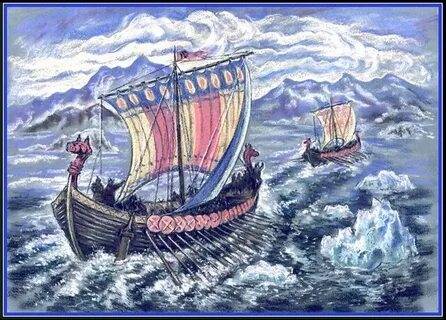
Illustration by I. Moshkin
В previous article was told about the geography of Russian epics of the Kyiv cycle. Today we will continue this story.
"Special" epics of the Kyiv cycle
Among the epics of the Kyiv cycle, two stand apart, which are traditionally included in it, but most likely written in Novgorod. The first of them is an epic about Nightingale Budimirovich, who sailed to woo the daughter of a Kyiv prince, who is now considered by many to be an “old man” of northern origin.
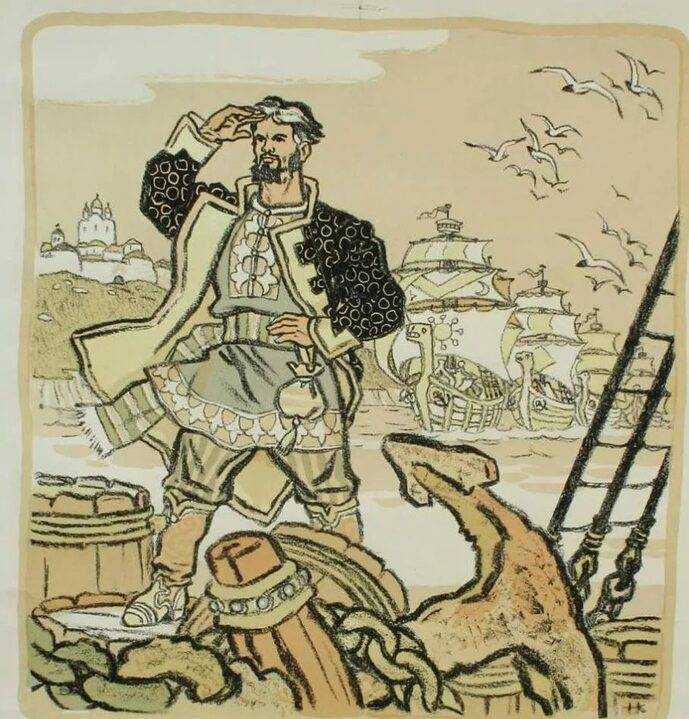
Nightingale Budimirovich illustrated by N. Kochergin
Firstly, the groom arrived in Kyiv from somewhere in the north, passing by Smolensk, perhaps even from the lands of the Western Slavs living on the coast of the Baltic Sea.
Secondly, the path of the protagonist is indicated in sufficient detail and reliably, which is typical for Novgorod epics. The nightingale sails from the city of "Ledenets" located in the land of "Vedenetskaya":
Because of that Kodolsky island,
Because of that lukomorya green.
Almost all researchers agree to consider the "Land of Vedenets" as "the land of Veneds". Even Caesar in his Notes on the Gallic War wrote about the Wends (Veneti):
In the writings of Claudius Ptolemy of Alexandria (XNUMXnd century AD), the Baltic Sea is called the Venedian Gulf, and the Carpathians are called the Venedian Mountains. And the Volyn Sea of Russian epics, including the one we are considering, is actually Volinsky: from the name of the island of Volin, on which the city of the same name was located, also known as Vineta, Yumna, and in Russia - as Vedenets (hence one step to Ledenets) .
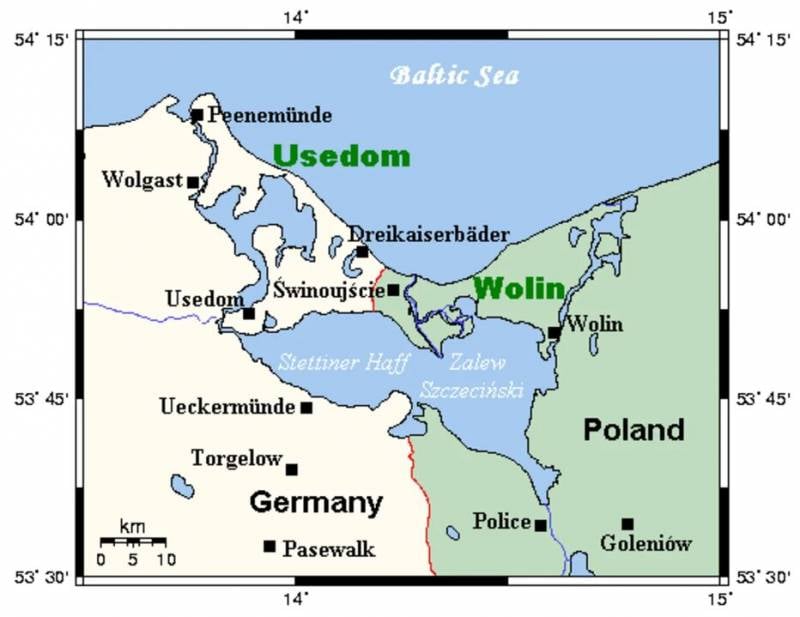
Wolin Island on the map
However, others see in Ledenets the Swedish trading city of Löddecöping, located not far from the Slavic (at that time) island of Ruyan (Rügen). The “Green Lukomorye” refers to the Baltic Sea, they argue only about localization: the Zeeland Lukomorye or the closer coast of the island of Ruyan between the Vittov peninsulas (where Arkona was located) and Jasmund, which had an arched shape. In this case, Gotland is most suitable for the role of Kodolsky Island, where in Visby (the main city of the island) the Novgorodians had not only houses and warehouses, but also the church of St. Nicholas.
And some believe that the name Ledenets could come from the city of Lindanissa, near which Revel later grew up (now Tallinn). Here, too, there was a permanent Novgorod colony. Kodolsky Island in this case will be Kotlin.
Still others even believe that Lollipop is Gle'den, a city that was located on the spot where Veliky Ustyug later grew up.
However, it is the first version that still looks the most logical and harmonious.
Everything seems completely incomprehensible and strange in the epic about Duke Stepanovich and his journey to Kyiv.
Duke Stepanovich - one of the snake fighters of Russian epics:

And he is also a skilled musician on a 1905 postcard:
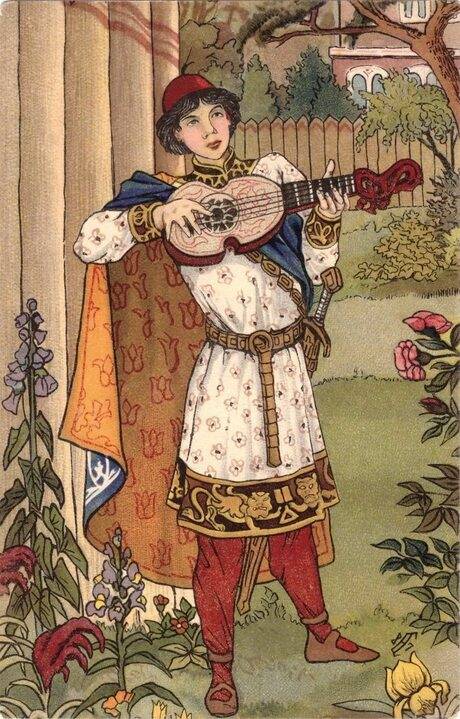
Duke arrived:
Yes, from that cursed Galicia,
From that glorious Volyngorod.
At the same time, the distance from Kyiv to the Galician land
It seems logical to assume that the Duke arrived from the Galicia-Volyn principality - the northern storytellers of geography simply did not know. But what about India? And why is Volyn a glorious city, and Galich a cursed one?
Many researchers believe that this epic, like the "old" about Nightingale Budimirovich, was written in Novgorod, and traces of Duke must be sought in the north. It removes almost all issues. We again meet with the Baltic Wends or Wends, whom the Germans called Winds (Inds - Wenden). And the Finns still call Russia the word Venaja, in which the name of the Slavic association of Wends is clearly heard. The same root in the Estonian word "vein", which the inhabitants of this country call Russians.
The fact is that the neighbors of the Finns and Estonians - the Novgorodians, unlike the Kyivans, originated from the Western Slavs-Vends, and not from the Eastern Slavs-Antes. That is, India may well be Vendia, Galicia - the land of the hostile Wends (and therefore cursed) Baltic tribe of the Galindai (Galindai), also known as the golyad, and under the name Volyn, Volin, already familiar to us, is probably hiding. In Scandinavia and Northern Germany, Wolin (Vineta, Volynets) was known as Yumna or Yom. At the peak of its power, this city was indeed very rich, Duke Stepanovich says about him:
Our churches are all stone,
And they are whitewashed with lime,
On the churches, there are semi-precious domes,
There are gilded lids on the houses,
Pavements are covered with ore-yellow sand,
You won’t get your green morocco boots dirty here.”
Adam Bremensky, a highly respected and serious author, agrees with Duke:
In Novgorod, as we have already said, Wends settled. Thus, the Novgorod author of the epic, talking about how a visiting hero shames the Kyiv dandies and the prince himself, who decided to compete with him in wealth, and easily wins three competitions, apparently emphasizes the superiority of Volin and Novgorod over Kyiv.
Novgorod epics
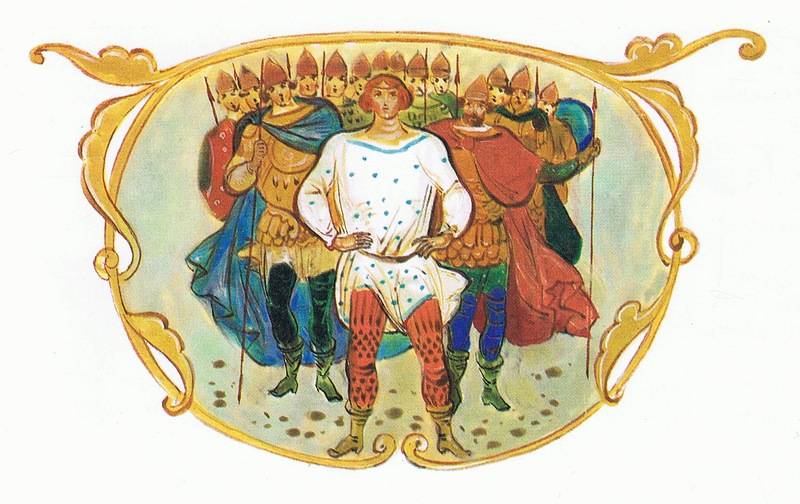
The epics of the Novgorod cycle are characterized by quite reliable geographical information. The same Vasily Buslaev does not come across fantastic rivers or cities on his journey to Jerusalem. He sails up the Lovat, then down the Dnieper to the Black Sea and visits Tsargrad (Constantinople) on the way. But the epics of the Kyiv cycle, the river "Yerdan" and the "city of Yersalim" are placed immediately after the Clean Field and the Holy Mountains - and no sea needs to be crossed.
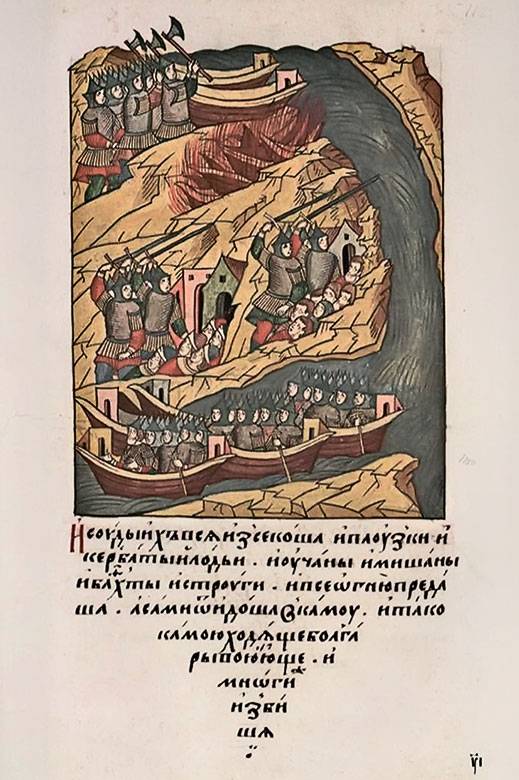
Novgorod earpieces, a miniature from the Illuminated Chronicle. This is what Vasily Buslaev's squad could look like
It is curious that in 1118 in Constantinople a certain “Scythian Basil, a merchant from Neapolis” (“New City”) committed a series of brawls and two massacres in the markets. At first, he managed to pay off, but when the number of local residents crippled by him exceeded fifty, this “Scythian” was still put in prison, from which he managed to escape by breaking the bars. Was this violent "merchant from the New City" one of the prototypes of the epic Vasily Buslaev? It is unlikely that the Byzantines would have called a "Scythian" a native of Italian Naples.
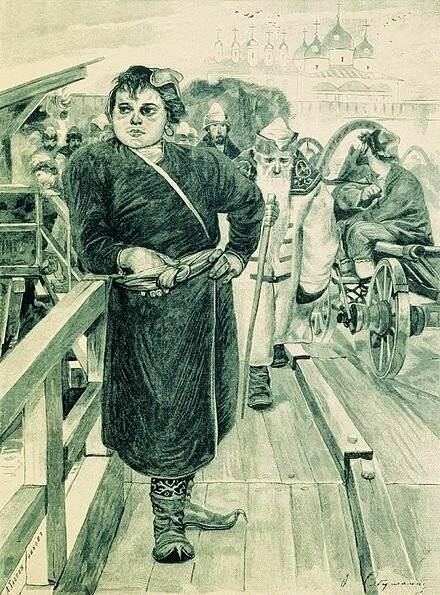
Vasily Buslaev as presented by A. Ryabushkin
Let us return to Vasily Buslaev, who in the Holy Land, contrary to the ban, bathed in the “Jordan River”, and then died upon returning to his homeland. Recorded epics offer two places of death of this hero.
According to the first version, this happened on Mount Zion - quite real, it is currently located on the territory of Jerusalem.
But other versions of the epic speak of Sorochinsky Mountain. In the epics of the Kyiv cycle, the Sorochinsky mountains (that is, the Saracens) are mentioned as the place where the Serpent Gorynych lives - the same one that Dobrynya Nikitich fought with.
In other later epics, the Sorochinsky mountains already serve as the border of Russian lands. According to the ideas of the storytellers, they were located in the southeast - in contrast to the Holy Mountains, which were in the southwest. And therefore, the heroic outpost on Sorochinsky Mountain in the epic "Ilya Muromets and Zhidovin" was probably not on the border with the epic Judea, but with Khazaria.
However, in the Novgorod epics, Sorochinskaya Mountain is located where it is supposed to be - on the Volga at the confluence of the Tsaritsa River - within the boundaries of modern Volgograd. This mountain was known in Novgorod - local merchants and ushkuyniki sailed to this place. That is, Vasily Buslaev returned through the Caspian and the Volga.
The route “to foreign countries” and another epic hero, Sadko, is also very accurately conveyed:
Ai from Volkhov, he is in Ladoga (lake).
And from Ladoga he sailed to the Neva River,
Ah, as from the Neva River, as I left for the blue sea.
It was in this way that Novgorod merchants and ushkuiniki got into the Baltic Sea, and India, which the hero visited, may turn out to be the Vendia we know.
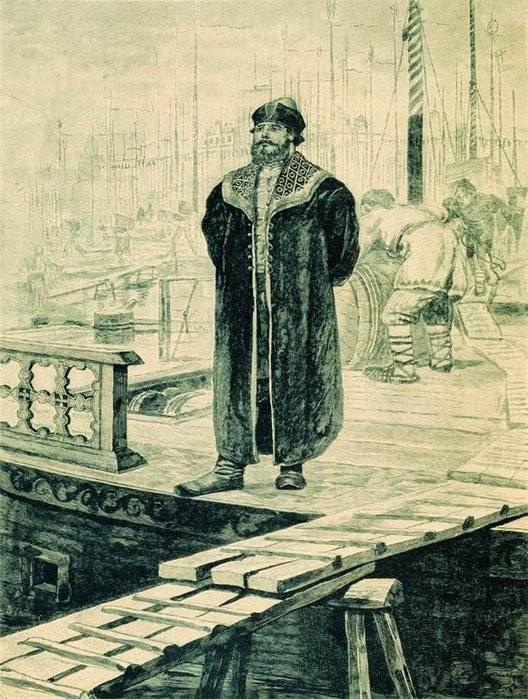
Andrei Ryabushkin. Sadko, a wealthy Novgorod guest, 1895
True, Sadko also visited the Golden Horde - it turns out that he went around Europe and returned through the Black Sea. Where, by the way, there are two constantly rotating whirlpools, forming a current from east to west in the northern part of the sea. And in the Sea of \uXNUMXb\uXNUMXbAzov, the Don arranges a whirlpool. It was here, according to some historians, that the ships of Sadko's squadron could "get stuck", who eventually had to jump overboard and go "on a visit" to the sea king. Being released by him, the hero wakes up on the banks of the real river Chernava.
But in such a trip around Europe is still not very hard to believe. Therefore, some researchers believe that Sadko's ships returned to Lake Ilmen, from where they passed through Msta to Vyshny Volok (Volochka) and dragged the ships to Tvertsa.
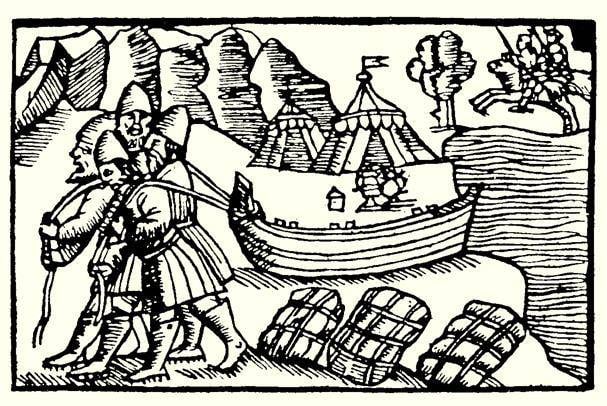
Shipwreck
Already from this river they could go down to the Volga and swim to Saray.
Other researchers believe that under the Golden Horde, the narrators understood the Russian principalities located to the south, which, unlike Novgorod, were actually one of the Horde uluses, and the Grand Duke received a label for rule from the Khan.
In addition, it must be remembered that in 1397, after the defeat from Timur-Kutlug and Edigey, Tokhtamysh left for the territory of the Grand Duchy of Lithuania, who still remained the great khan of the Jochi ulus. He even issued a label for the reign of the Grand Duke of Lithuania Vitovt. And therefore the Belarusian city of Lida, where Tokhtamysh's headquarters was temporarily located, could also be called the Golden Horde at that time.
By the way, the epic about Sadko ends with the promise of the hero to build a "cathedral church" in Novgorod. And at 25 historical Sources state that a certain Sotko (Sytko, Sotka) Sytinich (Sytinits, Stanich, Sotich), saved by Saint Nicholas, built the Church of Saints Boris and Gleb in the Novgorod citadel.
This is stated, in particular, in the Novgorod First Chronicle of both editions, the Novgorod Second, Novgorod Third, Fourth and Fifth Chronicles, in the Novgorod Karamzin, Novgorod Bolshakovskaya, Novgorod Uvarovskaya, Novgorod Zabelinskaya, Novgorodskaya Pogodinskaya Chronicles. And also in the Chronicler of the Novgorod rulers, the Pskov First Chronicle, the First Sofia, Perm, Tver, Resurrection and Nikon Chronicles. And also in the Moscow chronicle of the end of the XNUMXth century, Rogozhsky and Vladimir chroniclers.
14 sources speak of the laying of this church in 1167 on the site of the first wooden St. Sophia Cathedral, which burned down in 1049. Then you can find reports about the consecration of this church in 1173, about its restoration after a fire in 1441, and finally about its dismantling due to dilapidation in 1682. This church can be seen on the Khutyn icon of the XNUMXth-XNUMXth centuries:
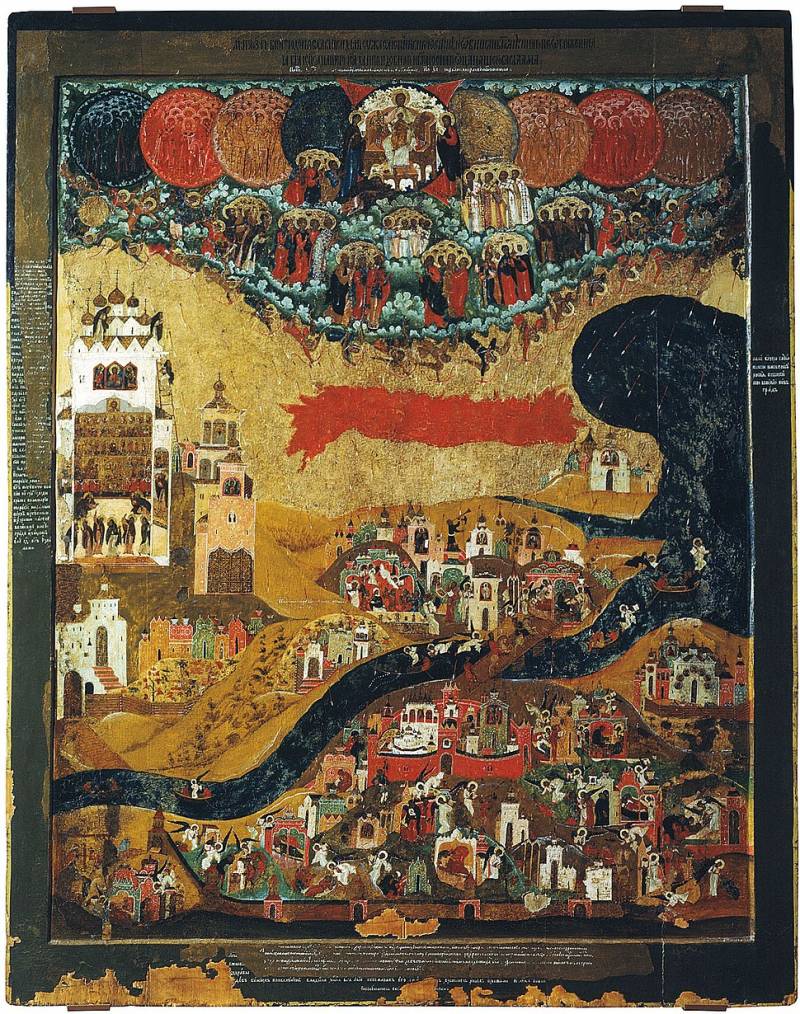
The Novgorod Detinets is depicted here, the Church of Boris and Gleb seems larger and taller than St. Sophia Cathedral
Such conscientiousness of the narrators brings the Novgorod epics closer to the Scandinavian sagas, which were composed by skalds only on the basis of personal impressions or stories of trustworthy people. Close trade and cultural ties between Novgorodians and their northern neighbors are also noted in Russian chronicles. The author of "The Tale of Bygone Years" directly says that the Novgorodians "came out" due to the increased influx of newcomers from across the sea:
Apparently, acquaintance with the northern literary tradition also influenced the Novgorod writers of epics.
Information